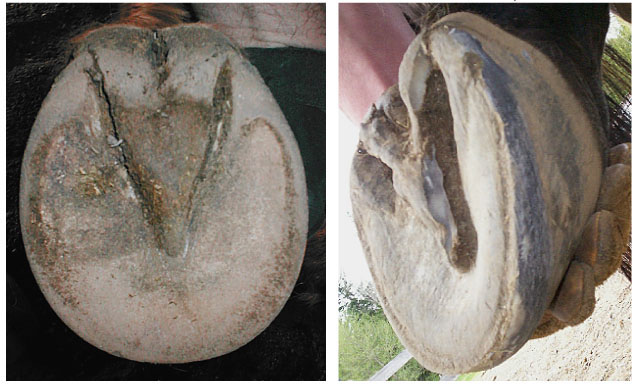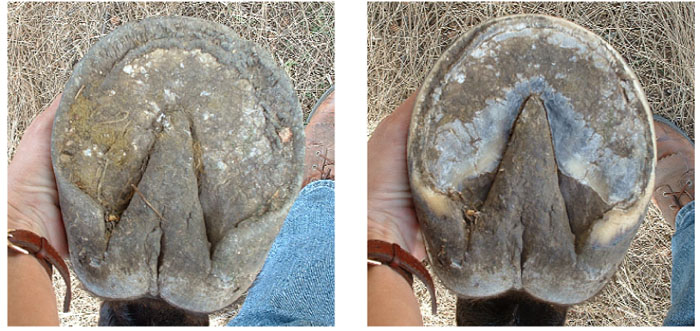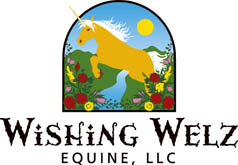
Hooves too hard to trim?
Or perfectly suited to the environment?
by Frances Guthrie ©2006
Here in beautiful British Columbia, the wet days of winter and
early spring have transformed to the drier, sunny warm weeks of the coming summer.
Muddy paddocks and rain-saturated pastures are mere memories—till next
fall.
Naturally, as the ground dries up and the terrain becomes firm,
hooves are affected. The walls and bars become stronger, the frogs get tough
and leathery, and the soles get hard. Farriers and barefoot trimmers alike may
be overheard commenting on “hard hooves.”
Those who don’t use power tools may lament the hardness of
the sole and bar horn in particular, as the sharpest hoof knife simply chatters
across the sole, only barely leaving a scratch. Even the hoof nippers may be
challenged by walls that are incredibly hard.
Soaking for hours—first the hooves, in an effort to soften
them, and then the trimmer’s muscles at the end of the day—becomes
a daily, unrewarding chore!
Is this a problem or a situation—what is the problem? Hooves are dynamic and adaptable, another of nature’s miracles... which leads me to observe that hard, tough hooves with thick soles and strong bars are perfectly suited to the situation!

Left: A perfectly adapted hard terrain front hoof. Note the
polishing of the heel/bulb/frog area. Right: This hind hoof just returned from
a riding holiday on very dry terrain—self-trimming for a couple of weeks,
nicely worn and lots of concavity!
In general, the horses I trim have very hydrated hooves through
the winter months; if the horses have some drier, rocky ground or cement floor
near the shelter, they remain healthy, maintain their form easily and are strong
and functional. This is not the case if horses are restricted to water-logged
pastures or muddy areas only, and problems such as loss of hoof height, soft
soles, and compromised white lines can develop.
So, what to do in the summer months when the hoof is so dry that
the sole and bars resist trimming? Well, I think (within reason, of course!)
that healthy hooves adapt quite well to the environment—hard and dry for
hard, dry terrain, softer and more flexible for wetter, soft terrain. It just
makes sense—how could a soft, flexible, moist hoof sustain the concussion
and impact of rocky, dry, unyielding terrain?
Mindful trimming requires us to re-consider perceptions and perspectives.
To look for answers in nature, learn from our observations. And perhaps to further
define our role as a hoof trimmer, just taking the place of inadequate movement
over abrasive dirt or stone! Of course, it’s not that simple, and hoof
care providers should be skilled, educated and knowledgeable.
Meanwhile, summer is here, and I’m liberated, free to admire
and appreciate strong, tough, dry hooves—hooves of flint, hooves of steel,
hooves like iron... they’re great!
Yes, the horn is harder to trim, and the rasp dulls faster. That’s perfection
in the horse world. Remember, firm terrain is just what the horse evolved towards
from a three-toed forest dweller.
Trimming a healthy hoof that is adapted to hard terrain—well,
it’s easy, really. If the heels have grown excessively, I trim them to
a height just above the sole. I may rasp the wall down a little to lightly scoop
the quarters. I always round (or bevel) the hoof wall—if you look in the
microscope, even a flat-appearing hoof wall on soft terrain is rounded! I remove
any flaring, ensure there is no dishing in the toe wall—trimming the toe
wall parallel to the coffin bone is really important. Correct breakover/toe
length is vital for healthy concavity, vertical toe height and to prevent contracting
forces on the heels.
I trim the bars level with the sole—if you do this with the
nippers, you won’t be trying to force your hoof knife to do an impossible
job. And the sole—if it is smooth and/or tightly connected, I leave it
alone (think sturdy soles on your mountain hiking boots). If it is shedding
in large, easy-to-remove chunks, I go ahead and help them off. It makes the
hoof pretty, and me feel good. But really, one more trail ride would probably
have done the job for you.
If your experience is trimming to specific parameters, it would
certainly be possible to form an opinion that adapting the trim and removing
less horn is an effort to avoid hard work. I’d do anything for the horses,
regardless of how hard the work—so in this case, I’m trimming less,
and the hard work is in the form of a willingness to trust that nature is always
right.
As I trim to suit the horses, their hoof form continues to improve, they move more comfortably, and I no longer hassle my clients to soak hooves beyond the overflowing water trough. Overly-hydrated hooves in a dry environment—what’s natural about that?

Left: A hoof from a horse located in an area that is dry
in the summer—and in need of a trim. Right: Same hoof, after trimming—with
hand tools only—working with nature as much as possible.
About the author: Former farrier and graduate of Dr Strasser’s certification course (2002), Frances incorporates the techniques of many popular barefoot trimming methods in her work. When she’s not consulting or trimming hooves, Frances is often found teaching natural horsemanship; her students learn to ride bareback and bitless—on barefoot horses, naturally!
This article was printed in issue 24 of The Horse's Hoof Magazine.
To order your subscription, please visit The
Horse's Hoof Store
©2006 by The Horse's Hoof. All rights reserved. No part of these publications may be reproduced by any means whatsoever without the written permission of the publisher and/or authors. The information contained within these articles is intended for educational purposes only, and not for diagnosing or medicinally prescribing in any way. Readers are cautioned to seek expert advice from a qualified health professional before pursuing any form of treatment on their animals. Opinions expressed herein are those of the authors and do not necessarily reflect those of the publisher.
The Horse's Hoof Website
Home - About Us - Horselover's
Corner - Articles - Barefoot
Performance - Barefoot Stories - Hoof
Gallery - Natural
Horse Care - EPSM
- The Horse's Hoof Clinics - Events
- Trimmers -
Pioneers - Friends
- Classified - Resources
- News - Links
To go shopping or subscribe to our magazine, please click here: The
Horse's Hoof Store
If you don't see a column to the left: To view the frames version of this site, please click here: TheHorsesHoof.com
The Horse's Hoof is a division of:

The Horse's Hoof
P.O. Box 1969
Queen Creek, AZ 85142
Phone (623) 935-1823
Message Phone: 1-623-935-1823
(Leave a message anytime.)
Email: editor @ TheHorsesHoof.com (delete spaces)